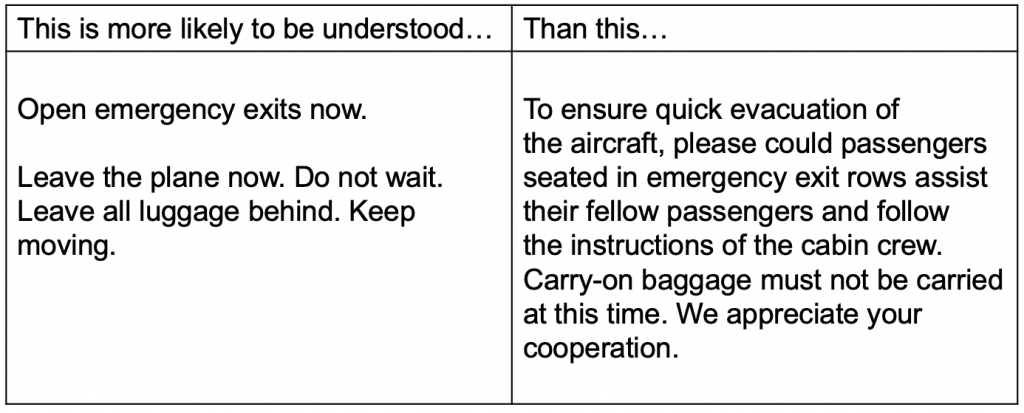
If you need to get people to act quickly when they’re facing danger, how should you communicate?
Whether it’s trying to evacuate people ahead of a storm, direct them away from danger – or explain the steps to take during any stressful situation – here are some important things to be aware of when you’re communicating in an emergency:
1. When we’re stressed, we are much less able to absorb and process information
Thinking is something we generally believe we’re doing all of the time. However, we get through a lot of life on autopilot. Thinking is, in fact, a biological luxury. We stop to do it only in safe and calm conditions – and we’re more likely to do it well if we’re rested and relaxed. Under stressful conditions like an emergency, our brains divert energy to activities that are more likely to help us survive – like running or screaming.
So if you’re communicating with people who are under intense pressure, remember that their thinking and processing capability is going to be greatly reduced. So keep it super-simple. Use short words. Don’t make more than one point in a sentence. And present your information in sequential order.
Short words

One point per sentence

Sequential order (saying things in the order they should happen)

2. When we’re stressed, we don’t remember a lot
Again, in moments of high stress and crisis, human brains do not waste energy holding onto information or considering past or future. Consciousness zoom focusses on the immediate present. So be prepared to repeat information frequently. Keep moving. Keep moving. Keep moving.
3. In an emergency, people wait for someone else to take responsibility
In moments of extreme stress, the human mind goes through distinct stages. First, it denies what’s happening. This can’t be true, it isn’t real. Second, the brain tries to decide what to do. What the heck do I do now? Then, some take action. Though not necessarily good actions.
Very often though, people hover at the denial/deliberation stage – especially if there are other people around. Because what happens then is that most people wait for someone else to take the lead. Psychologists call this a “diffusion of responsibility”.
So if you need people to follow you or do what you say, you need to assume a position of authority and responsibility. Keep calm and speak clearly and loudly enough for people to hear. Merely taking the lead in emergency situations can often be enough for people to follow you and do as you say.
4. Stressed people need specifics
Even mild states of stress can make intelligent people unable to think creatively. Holiday companies often say to their reps: “Your guests will leave their brains at the airport… and it’s their complete right to do so.”
The stress of travel, luggage, potentially missing connections and all the other things that happen on a journey is enough to make normally brainy people find it difficult to understand that Coach A is their transfer bus, and it will be leaving in 20 minutes.
So in a more threatening situation, you have to remember to be super-specific:
Stand exactly here. Stay here until I come back. Do not move.
Why would you ever need to know this?
Crises, by their very nature, are unpredictable – so you never know when you might need to take the lead in an emergency.
More generally, these are principles that help all communicators to better understand how to pitch information in potentially stressful circumstances. If, for example, you’re writing a leaflet for people who’ve recently been diagnosed with a life-threatening condition, or instructions for taking the window out of a train, or a brochure for a funeral director, all of these principles can apply.
As ever, if you’d like to talk to us about your communications, we’d be really interested to hear your challenges. Get in touch here.
